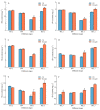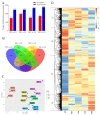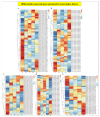Drought Stress Stimulates the Terpenoid Backbone and Triterpenoid Biosynthesis Pathway to Promote the Synthesis of Saikosaponin in Bupleurum chinense DC. Roots
- PMID: 36080237
- PMCID: PMC9457724
- DOI: 10.3390/molecules27175470
Drought Stress Stimulates the Terpenoid Backbone and Triterpenoid Biosynthesis Pathway to Promote the Synthesis of Saikosaponin in Bupleurum chinense DC. Roots
Abstract
Bupleurum chinense is an important medicinal plant in China; however, little is known regarding how this plant transcribes and synthesizes saikosaponins under drought stress. Herein, we investigated how drought stress stimulates the transcriptional changes of B. chinense to synthesize saikosaponins. Short-term drought stress induced the accumulation of saikosaponins, especially from the first re-watering stage (RD_1 stage) to the second re-watering stage (RD_2 stage). Saikosaponin-a and saikosaponin-d increased by 84.60% and 75.13%, respectively, from the RD_1 stage to the RD_2 stage. Drought stress also stimulated a rapid increase in the levels of the hormones abscisic acid, salicylic acid, and jasmonic acid. We screened 49 Unigenes regarding the terpenoid backbone and triterpenoid biosynthesis, of which 33 differential genes were significantly up-regulated during drought stress. Moreover, one P450 and two UGTs are possibly involved in the synthesis of saikosaponins, while some transcription factors may be involved in regulating the expression of key enzyme genes. Our study provides a reference for the cultivation of B. chinense and a practical means to ensure the quality (safety and effectiveness) of B. chinense for medicinal use, as well as insights into the modernization of the China Agriculture Research System.
Keywords: Bupleurum chinense DC.; drought stress; plant hormones; saikosaponins; terpenoid backbone and triterpenoid biosynthesis.
Conflict of interest statement
The authors declare no conflict of interest.
Figures









Similar articles
-
Strategies for increasing saikosaponins accumulation in Bupleurum: insights from environmental and microbial regulation.Planta. 2025 Jun 23;262(2):35. doi: 10.1007/s00425-025-04748-4. Planta. 2025. PMID: 40549222 Review.
-
Effects of drought-re-watering-drought on the photosynthesis physiology and secondary metabolite production of Bupleurum chinense DC.Plant Cell Rep. 2019 Sep;38(9):1181-1197. doi: 10.1007/s00299-019-02436-8. Epub 2019 Jun 4. Plant Cell Rep. 2019. PMID: 31165250
-
Drought stress induces biosynthesis of flavonoids in leaves and saikosaponins in roots of Bupleurum chinense DC.Phytochemistry. 2020 Sep;177:112434. doi: 10.1016/j.phytochem.2020.112434. Epub 2020 Jun 13. Phytochemistry. 2020. PMID: 32544729
-
Transcriptome analysis of Bupleurum chinense focusing on genes involved in the biosynthesis of saikosaponins.BMC Genomics. 2011 Nov 2;12:539. doi: 10.1186/1471-2164-12-539. BMC Genomics. 2011. PMID: 22047182 Free PMC article.
-
Putative genes involved in saikosaponin biosynthesis in Bupleurum species.Int J Mol Sci. 2013 Jun 19;14(6):12806-26. doi: 10.3390/ijms140612806. Int J Mol Sci. 2013. PMID: 23783277 Free PMC article. Review.
Cited by
-
High-quality assembly of the chromosomal genome for Flemingia macrophylla reveals genomic structural characteristics.BMC Genomics. 2025 May 26;26(1):535. doi: 10.1186/s12864-025-11705-8. BMC Genomics. 2025. PMID: 40419955 Free PMC article.
-
Strategies for increasing saikosaponins accumulation in Bupleurum: insights from environmental and microbial regulation.Planta. 2025 Jun 23;262(2):35. doi: 10.1007/s00425-025-04748-4. Planta. 2025. PMID: 40549222 Review.
-
Suitable concentrations of brassinolide application enhances growth performance and saikosaponin biosynthesis by transcriptional activation of triterpenoid pathway genes in Bupleurum chinense DC.Front Plant Sci. 2025 Mar 31;16:1517434. doi: 10.3389/fpls.2025.1517434. eCollection 2025. Front Plant Sci. 2025. PMID: 40230607 Free PMC article.
-
Genome-wide identification of the bHLH gene family in Scutellaria baicalensis and their relationship with baicalin biosynthesis under drought stress.Front Plant Sci. 2025 Jan 27;15:1506805. doi: 10.3389/fpls.2024.1506805. eCollection 2024. Front Plant Sci. 2025. PMID: 39931340 Free PMC article.
-
Metabonomics Analysis Reveals the Influence Mechanism of Three Potassium Levels on the Growth, Metabolism and Accumulation of Medicinal Components of Bupleurum scorzonerifolium Willd. (Apiaceae).Biology (Basel). 2025 Apr 22;14(5):452. doi: 10.3390/biology14050452. Biology (Basel). 2025. PMID: 40427642 Free PMC article.
References
-
- Shahrajabian M.H., Sun W., Cheng Q. Traditional Chinese medicine and agriculture; organic life and sustainability for future. GSC Biol. Pharm. Sci. 2019;7:91–95.
-
- Tian R.-T., Xie P.-S., Liu H.-P. Evaluation of traditional Chinese herbal medicine: Chaihu (Bupleuri Radix) by both high-performance liquid chromatographic and high-performance thin-layer chromatographic fingerprint and chemometric analysis. J. Chromatogr. 2009;1216:2150–2155. doi: 10.1016/j.chroma.2008.10.127. - DOI - PubMed
-
- Zhu L., Liang Z.-T., Yi T., Ma Y., Zhao Z.-Z., Guo B.-L., Zhang J.-Y., Chen H.-B. Comparison of chemical profiles between the root and aerial parts from three Bupleurum species based on a UHPLC-QTOF-MS metabolomics approach. BMC Complement. Altern. Med. 2017;17:305. doi: 10.1186/s12906-017-1816-y. - DOI - PMC - PubMed
-
- Mohiuddin A. Environmental impact of secondary metabolism on medicinal plants. J. Glob. Biosci. 2019;8:5890–5899.
MeSH terms
Substances
Supplementary concepts
Grants and funding
LinkOut - more resources
Full Text Sources
Miscellaneous

